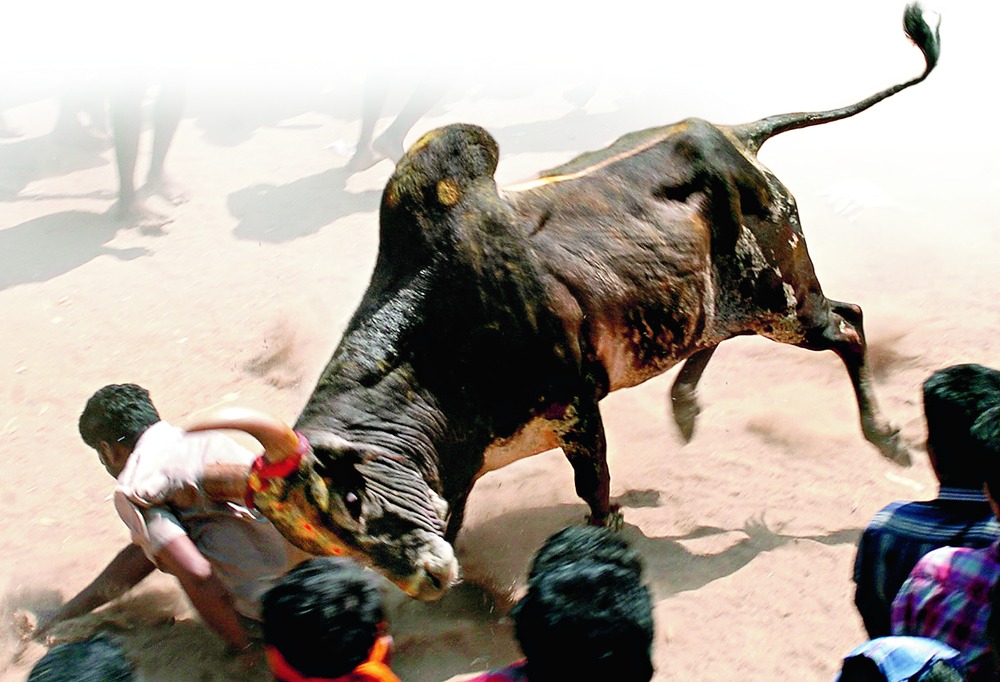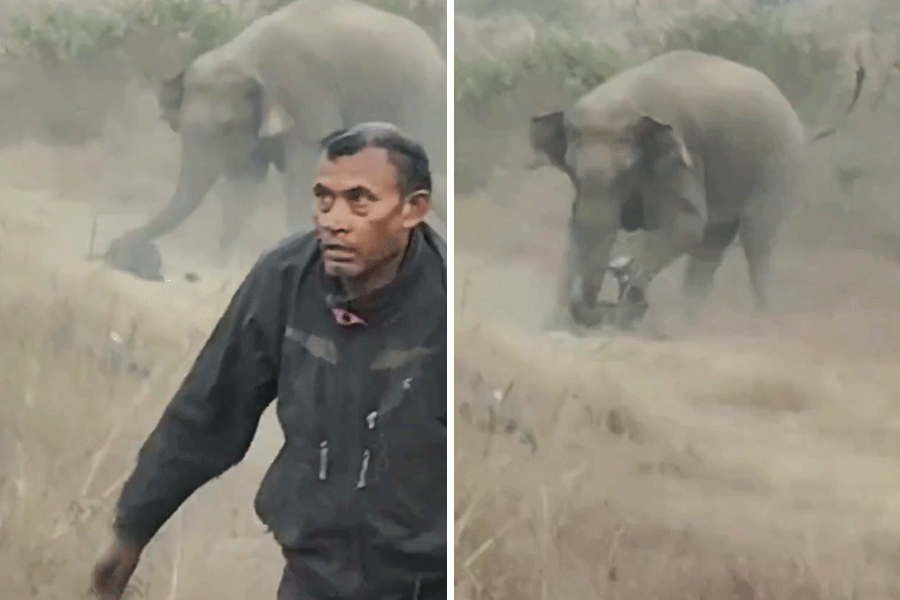
Pandi feels less of a man today. The olden habit of giving a periodic twirl to his majestic moustache and feel the testosterone surge as he slaps his muscular thighs in anticipation of a challenge to his manliness seems to be ebbing.
That's the way it has been, not just for him, but most men of Karupayuvani, a village in the heart of Tamil Nadu, ever since jallikattu, the bull-taming sport, was banned by the Supreme Court two years ago.
Karupayuvani is in Madurai district; Madurai of the ornate, towering Dravidian temples, of jasmine and jigarthanda (a south Indian falooda), of the now dwindled fief of M.K. Alagiri, and of jallikattu.
Recently, the Supreme Court dismissed a plea by the Tamil Nadu government to review its 2014 Animal Welfare Board of India vs A. Nagaraja judgment banning the sport because of its inherent "cruelty" towards the bull.
This is how the sport plays out. A gaggle of young men wait inside the arena. Outside, in the stalls are cheering crowds. The stud bulls are lined up behind a trap door that opens onto the arena. The trap's dropped and the bulls are released in, one at a time. Adrenaline spills over, within and beyond the arena. The jostling starts. The cheering deafens. The men lunge for the hump of the bull. The rules are clear - you can catch the bull only by its hump. The man who does so and manages to hold on to it till the bull crosses the finish line, wins. He also has to remove the chain or cloth around the bull's neck and horns. It is bull taming, not fighting, jallikattu enthusiasts argue.
At last check, bull and aspiring tamer spend no more than 30 seconds in the arena.
Pandi cannot understand what the big deal is. He has participated in jallikattu since he was a teenager, like his forefathers before him. In a way the sport has defined him. He was known far and wide for his agility, his ability to tame many a fearsome stud bull. It had got him a slew of gifts - cycles, silver coins, a television set. It also won him a wife.
Pandi is not the only one to be picked as suitable groom for his jallikattu skills. Across many a Tamil Nadu village, fathers of daughters prefer jallikattu heroes as sons-in-law. "If a man can fearlessly face a raging bull [ Kangayams or Pulikulams], a father believes, he is capable of protecting his daughter even if he is faced with 10 men... Fathers in our part of the world look for bravery in a man, not for money," says Pandi, sitting with other village men under a banyan tree.
If the bull tamer has his rewards, so does the bull. The one that resists being tamed and puts up a good fight is marked for breeding and his progeny is always in demand at cattle fairs, says Karthikeyan Sivasenapathy of a Tirupur-based cattle research foundation.
Karupayuvani's temple bull, decked in red flowers and tied before the village stone god, displays no signs of ferocity except against the flies. No one can tussle with a temple bull. The villagers line up two other frisky stud bulls purchased as calves at cattle fairs.

"It is a source of pride to own a bull and enter it in a jallikattu. But, today, maintaining them at Rs 200 a day [that's what the fodder costs] is tough," admits Karuppana, who is also from Karupayuvani. He adds that after the ban, many bull owners are selling their animals.
The widowed Selvarani from a neighbouring village, one of the rare intrepid Tamil women to enter her prize-winning stud bull in jallikattu, swears she will never sell her Ramu. "He is akin to Lord Shiva and wards off evil. How can I send him to the beef markets of Kerala?"
Selvarani scorns at the state government's 2009 regulations for jallikattu events before the ban. She points out, "The authorities used to object to rubbing the bull's horns with manjal (turmeric) powder for religious and decorative purposes. Can we give alcohol to an animal we regard as god or rub its eyes with chilli powder?" she asks, clearly outraged about the breath analyser tests for bulls and players.
Animal rights activists claim players disorient the bulls with alcohol and chilli powder on purpose - to score one up on them.
Experts disagree that jallikattu is all about the naked display of machismo. But over the years Tamil movies such as Rajinikanth's debut film Muratu Kalai and Kamal Haasan's Virumandi have used it to drive home the hero's manliness and virility. (Haasan is against the ban since he believes the sport is deeply embedded in Tamil rural culture.) Balakumar Somu, a Coimbatore-based animal rights activist and jallikattu supporter, says, "It is a raw show of might in a positive sense. In Tamil culture, we have other strength-testing shows like elavata kal (lifting a heavy stone) in villages. A bull is a territorial male who loves to prove that he is an alpha male. The youth get a chance to show off their valour in front of young women. And, people fall in love at jallikattu events..."
Perumal Murugan, the famous literary chronicler of rural Tamil life, believes jallikattu is not just about proving one's masculinity and courage. "Jallikattu is about the strong bond between a farmer and his land. The farmer rears his cattle, uses it for agriculture, worships it and makes it a part of his family. He knows how to look after it and has every right to play with it if he wants," says Murugan.
It is like kabaddi, say the villagers, proudly displaying scars in different parts of their body from injuries inflicted by the jallikattu bull. "We don't let these small injuries deter us. Men who die here, which is rare [they quickly add], are hailed as bravehearts," says Pandi, relating the story of a tamer who despite being gored by a bull kept urging his fellow villagers to ignore his spilling guts and concentrate on taming the bull.
"It may seem gory for the faint-hearted but jallikattu seems tied to heritage and institutional Tamil memory. There are statues and hoardings erected on the roadsides commemorating a prized stud bull. Villages compete with one another to be recognised for their bold men. Victorious men strut around the village with the cloth they plucked from the jallikattu bull proudly flung on their shoulder for days," says Julian Prakash, a director, whose debut Tamil film around jallikattu released last week.
There is a reference to jallikattu in Kalithogai, a Tamil anthology of poems from the ancient Sangam literature. Many question the criticism against the celebration of Tamilian machismo. "What is wrong with that? The game is an intrinsic part of our Tamil culture and we need the bulls to serve the cows," says Sundar Ganesan, director of the Roja Muthiah Research Library in Chennai.
"Women have entered many fields and given a chance will step inside the arena too. But, they respect the important place it holds for men and leave it to us," observes P. Bala Subramanian, a jallikattu organiser.
Is jallikattu facing extinction? Well then, so is a way of life in parts of rural Tamil Nadu where the spectator sport is twined to the way people are.
ARENA MACHISMO: A GLOBAL INDEX
Bull-fighting is not peculiar to India. Its variants are popular with men in many cultures
![]()
SPAIN
• Men on horseback, known as picadors, enter the arena, attack and injure the bull with lances
• Banderilleros enter on foot. They prick the bull with spikes, causing blood loss. They run in circles until the animals becomes dizzy
• The matador tries to kill the bull with his sword. If he cannot, an executioner is called in to cut the animal’s spinal cord
MEXICO
• Very similar to the Spanish bull fight
• The matador teases the animal with a cap before killing it with a sword
• Home to the world’s biggest bullfighting ring
PORTUGAL
• First, a horseman stabs the bull with small javelins
• Next, a group of eight men challenge the bull directly. They do so without any protection or weapon
• One man grabs the animal’s head. Others surround and secure the animal, pull his tail until he is subdued
• The bull is not killed in the ring but dragged out and left bleeding France
• For a period of about 15-20 minutes, the players or raseteurs compete to snatch rosettes tied between the bull’s horns
US
• The rider gets on a bull and tries to stay mounted for full eight seconds while the animal tries to shake him off











